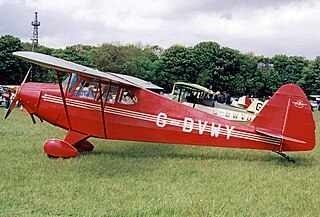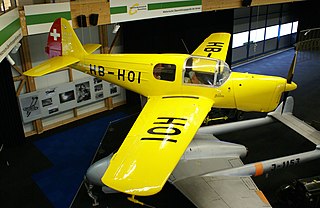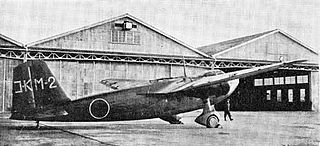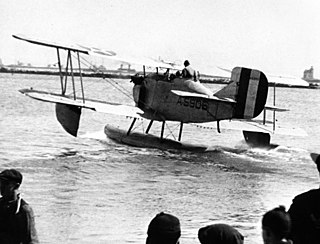| Model 33 | |
|---|---|
 | |
| Fleetwings 33 at Langley | |
| Role | Primary trainer |
| Manufacturer | Fleetwings |
| First flight | 1940 |
| Number built | 1 |
The Fleetwings Model 33 was a 1940s American primary trainer prototype airplane built by Fleetwings.
| Model 33 | |
|---|---|
 | |
| Fleetwings 33 at Langley | |
| Role | Primary trainer |
| Manufacturer | Fleetwings |
| First flight | 1940 |
| Number built | 1 |
The Fleetwings Model 33 was a 1940s American primary trainer prototype airplane built by Fleetwings.
During 1940, the Fleetwings company designed and built a two-seat primary trainer, the Model 33. Although the company were experts with stainless-steel construction the aircraft was built from light-alloy. It was a cantilever low-wing monoplane with a conventional tail unit and fixed tailwheel landing gear, powered by Franklin 6AC piston engine. The instructor and pupil were accommodated in two tandem open cockpits. Only the prototype was built.
Data from The Illustrated Encyclopedia of Aircraft (Part Work 1982-1985), 1985, Orbis Publishing
General characteristics
Performance

The Consolidated XP4Y Corregidor was an American twin-engined long-range maritime patrol flying boat built by Consolidated Aircraft for the United States Navy. Only one was built and a production order for 200 was cancelled.

The Comte AC-4 Gentleman was a 1920s Swiss two-seat sport/training aircraft produced by Flugzeugbau A. Comte.

The Stinson Voyager was a 1940s American light utility monoplane built by the Stinson Aircraft Company.

The Fleetwings BT-12 Sophomore, also known by the company designation Model 23, was a 1940s all-metal basic training monoplane built by Fleetwings for the United States Army Air Forces. Only 24 production examples of the type were built before the contract was cancelled.

The Harlow PJC-2 was a 1930s American four-seat cabin monoplane, designed by Max Harlow.

The Porterfield Collegiate is an American-built two-seat training and touring monoplane built by the Porterfield Aircraft Corporation of Kansas City.

The Fleet 50 Freighter was a Canadian twin-engine biplane general utility aircraft designed and built by Fleet Aircraft. This peculiar-looking aircraft had promise as a freighter and general use aircraft, but it was underpowered and only five were built.

The Fairchild 22 Model C7 was an American two-seat touring or training monoplane designed and built by the Kreider-Reisner division of the Fairchild Aircraft Corporation at Hagerstown, Maryland.
The Hiro G2H was a 1930s Japanese bomber or reconnaissance monoplane designed and built by the Hiro Naval Arsenal for the Imperial Japanese Navy.

The Nord 1200 Norécrin is a French two or three-seat cabin monoplane designed and built by Nord Aviation.

The Boeing AT-15 was an American twin-engined bomber crew trainer designed and built by Boeing's Wichita Division. Only two prototypes, designated XAT-15, were built. Plans to build over 1,000 were cancelled on the United States' entry into the Second World War.

The Koolhoven F.K.56 was a 1930s Dutch basic training monoplane designed and built by Koolhoven.
The Bréguet 790 Nautilus was a prototype French three-seat coastal patrol flying-boat designed and built by Bréguet Aviation to meet a requirement from the French navy.

The Mitsubishi K7M was a 1930s Japanese experimental crew trainer built by Mitsubishi for the Imperial Japanese Navy to replace the K3M.

The Aeronca C-1 Cadet was a high performance version of the Aeronca C-2 developed by Aeronca and first flown in 1931.

The Caproni Ca.90 was a prototype Italian heavy bomber designed and built by Caproni. When it first flew in 1929 it was the largest land-based aircraft in the world.
The Yatsenko I-28 was a 1930s Soviet single-seat fighter designed by Vladmir Yatsenko and first flown in 1939. The I-28 was a low-wing cantilever monoplane of mixed construction powered by a 900 hp (671 kW) Tumansky M-87 radial piston engine. It had an enclosed single-seat cockpit with a rearwards sliding canopy. The wing had an inverted-gull shape to reduce the length of the retractable main landing legs. The prototype was destroyed shortly after the first flight but an order was placed for 30 production aircraft. Also ordered was a prototype of an attack version, the I-28Sh. Although the first five production aircraft were completed the programme was cancelled in early 1940.

The IAR 27 was a 1930s Romanian two-seat low-wing monoplane primary trainer designed and built by Industria Aeronautică Română.
The Hillson Helvellyn was a 1940s British two-seat training monoplane designed by Norman Sykes and built by F Hills & Sons of Trafford Park.

G Elias & Brother was and American manufacturer of cabinets and aircraft based in Buffalo, New York in the 1920s. A.G. Elias sat on the Manufacturers Aircraft Association's board of directors along with President Frank H. Russell, VP Glenn L. Martin, Charles L. Laurence, Chance M. Vought, S.S. Bradley, George P. Tidmarsh, and Donald Douglas. E.J Elias promoted the construction of a Buffalo municipal airport to aid the local fledgling airplane industry of five aviation companies constructing airplanes and airplane parts. From 1920 to 1925, Elias company's chief engineer, David Earle Dunlap (1896-1957), designed the Elias EM-2 Expeditionary planes. He designed the NBS-3 bomber fuselage and the Elias M-1 Mail plane. Dunlap's Elias TA-1 design was the first United States Army Air Corps Trainer to have a radial engine. After tests a McCook Field, the Army Air Corps selected other manufacturers over the Elias bomber and trainer. The company designed the Elias EM-1 to meet requirements for a multirole amphibian marine expeditionary aircraft. Elias delivered six production Elias EM-2 aircraft with Liberty engines to the United States Navy in 1922.
| Wikimedia Commons has media related to Fleetwings 33 . |